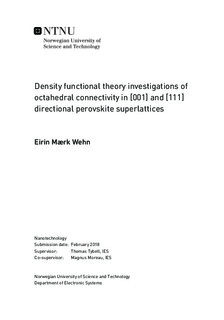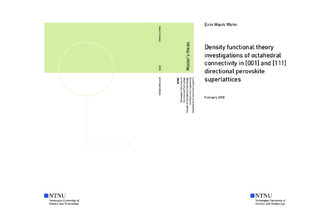| dc.description.abstract | To be able to exploit the magnetic properties of antiferromagnetic transition metal oxide perovskites in spintronic devices, as magnetic random access memory (MRAM) devices, a better understanding of how these magnetic properties may be controlled is crucial. Due to the strong coupling between structure and magnetic properties in such materials, a promising route to control and tune these properties is by means of structural control. An important structural parameter in perovskites is the BO6 octahedron, and structural distortions corresponding to distortions of these octahedra have been the main focus in this master thesis.
The octahedral distortions in superlattices of antiferromagnetic LaFeO3 (LFO) and non-magnetic SrTiO3 (STO) has been investigated using density functional theory (DFT). Superlattices with various film layer thicknesses - ranging from one octahedral unit to six octahedral units - and orientation - where both [001] and [111] oriented superlattices have been investigated, - were tested to look at how these factors affected the octahedral distortions in the superlattices. This was done by performing two different calculation methods - phonon mode calculations and structural calculations. In this way, it was also investigation whether the phonon mode calculation method actually could be used to investigate how different factors influenced the structure of the superlattices, or whether the conventional structure calculation method should be used to investigate such effects.
The results indicated that the octahedral distortions - corresponding to octahedral rotations, - in the superlattices were affected by both the film layer thicknesses and the superlattice orientation. The film layer thicknesses were found to mainly affect the rotation magnitudes in the different film layers, while the orientation could affect the overall tilt pattern in the film layers. The results were generally consistent for the two different kinds of calculation methods, indicating that phonon mode calculations can be used to investigate how structures in superlattices are affected by different factors. Hence, it was found that octahedral control in superlattices of LFO and STO can be obtained. This control might make it possible to tune the magnetic properties of LFO film layers in such superlattices. | |

